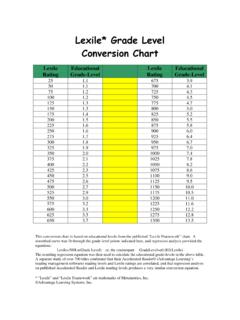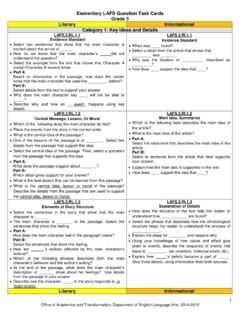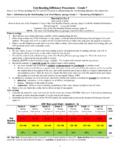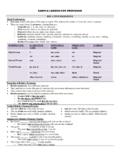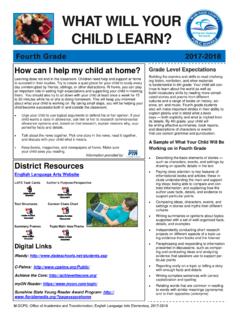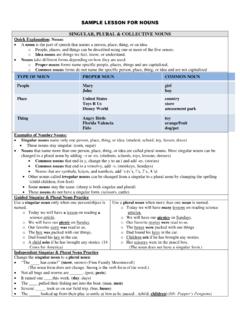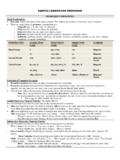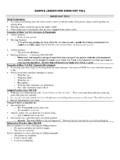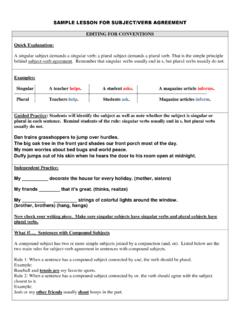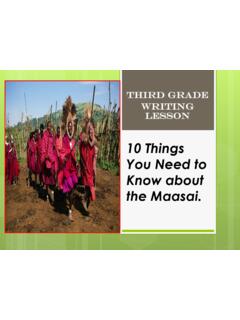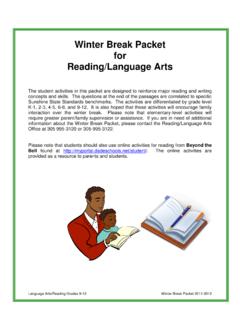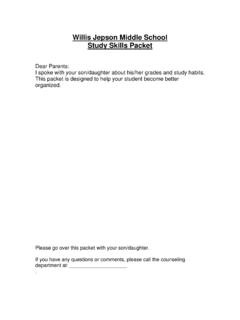Transcription of Grades 3-5 - English Language Arts (ELA)
1 Language Arts/Reading Winter Express Grades 3-5. Winter 2012-2013. Miami-Dade County Public Schools Office of Academics and Transformation Language Arts/Reading Winter Packet THE SCHOOL BOARD OF MIAMI-DADE COUNTY, FLORIDA. Perla Tabares Hantman, Chair Dr. Martin Karp, Vice Chair Dr. Dorothy Bendross-Mindingall Susie V. Castillo Carlos L. Curbelo Dr. Lawrence S. Feldman Dr. Wilbert Tee Holloway Dr. Marta P rez Raquel A. Regalado Jude Bruno Student Advisor Alberto M. Carvalho Superintendent of Schools Milagros R. Fornell Chief Academic Officer Office of Academics and Transformation Marie L. Izquierdo Assistant Superintendent Academics, Accountability and School Improvement Office of Academics and Transformation Karen Spigler Administrative Director Department of Language Arts/Reading Language Arts/Reading Winter Packet Table of Contents Welcome to the Language Arts/Reading Winter Express.
2 4. Winter Celebrations Throughout the World .. 7. Which Holiday Do You Celebrate Cube Activity .. 11. A Tourist in Your Own Town .. 12. Vocabulary- Christmas Around the World .. 13. Winter Solstice .. 14. Loved the Book Not Sure About the Movie .. 16. Read in the New Year .. 18. Language Arts/Reading Winter Packet Welcome to the Language Arts/Reading Winter Express The purpose of the Winter Express is to have your child experience quality literature and various reading explanations while school is out for winter break. Attached you will find a list of appropriate grade-level books that can be found in the public library, reading excerpts, and grade level activities that may be used to enhance the winter reading experience for students. The reading materials and activities are reflective of different learning styles, and guide students in applying concepts they have studied.
3 Activities address and are aligned with State Standards and Common Core State Standards providing continuous opportunities for our students to move along a continuum of learning experiences that will empower and build their confidence as learners. We encourage both students and parents to participate and make this winter reading experience fun and enjoyable for the whole family. Language Arts/Reading Winter Packet Third Grade Elements of Story Structure Character, Character Development, Setting, Plot, Problem/Solution. ( , ). Main idea, relevant supporting details, strongly implied message, inference, and chronological order. ( , , ). Identify the author's purpose ( , to inform, entertain, or explain) in text and how an author's perspective influences text. ( , ). Identify themes or topics across a variety of fiction an non-fiction selections. ( , ).
4 Identify the text structure an author uses ( , comparison/contrast, cause/effect, and sequence of events) and explain how it impacts meaning in text. ( , ). Write a variety of communications ( , friendly letter, thank-you notes, formal letters, messages, invitations) ( , , , , , ). Write in a variety of informational/expository forms ( , rules, summaries, procedures, recipes, notes/messages, labels, instructions, graphs/tables, experiments, rubrics) ( , , , , , ). Generating ideas from multiple sources ( , text, brainstorming, graphic organizer, drawing, writer's notebook, group discussion, printed material) ( , Fourth Grade Identify themes or topics across a variety of fiction and non-fiction selections Compare and contrast elements in multiple texts ( , setting, characters, problems). Identify and explain the elements of plot structure, including exposition, setting, character development, problem/resolution, and theme in a variety of fiction Determine explicit ideas and information in grade-level text, including but not limited to main idea, relevant supporting details, implied message, inferences, chronological order of events, summarizing, and paraphrasing Read informational text and text features ( , format, graphics, legends, illustrations, diagrams) to organize information for different purposes ( being informed, following multi-step directions, creating a report, conducting interviews, preparing to take a test, performing a task Write informational/expository essays that contain introductory, body, and concluding paragraphs Determining the purpose ( , to entertain, to inform, to communicate, to persuade)))
5 And the intended audience of a writing piece). Language Arts/Reading Winter Packet Fifth Grade Identify the author's purpose ( , to persuade, inform, entertain, explain). and how an author's perspective influences text Determine the main idea or essential message in grade-level text through inferring, paraphrasing, summarizing, and identifying relevant details Use strategies to repair comprehension of grade-appropriate text when self- monitoring indicates confusion, including but not limited to rereading, checking context clues, predicting, note-making, summarizing, using graphic and semantic organizers, questioning, and clarifying by checking other source Write informational/expository essays that state a thesis with a narrow focus, contain introductory, body, and concluding paragraph Language Arts/Reading Winter Packet Winter Celebration throughout the World Junkanoo is a street parade with music which occurs in many towns across the Bahamas, United Kingdom, Hong Kong, Australia, Canada, New Zealand.
6 And some other Commonwealth nations. It is traditionally celebrated every Boxing Day, the day following th th th Christmas Day, December 26 . It is believed that this festival began during the 16 and 17. centuries. The slaves in The Bahamas were given a special holiday around Christmas time, when they would be able to leave the plantations to be with their family and celebrate the holidays with African dance, music, and costumes. This tradition has continued and Junkanoo has evolved from its simple origins to a more formal, organized parade with sophisticated, intricate costumes, themed music and prizes. It is a celebration where people wear masks and dance to music in the streets beginning at 2 am and ending at dawn. Kwanzaa is a celebration that has its roots in the Black Nationalist movement of the 1960's and was established as a means to help African Americans reconnect with their African cultural and historical heritage.
7 It was created by Maulana Karenga and first celebrated in 1966-1967. Traditionally it is observed from December 26 to January 1. culminating in a feast and gift-giving celebration. This is a week-long celebration held in the United States and Canada, and each day represents one of the seven core principles (Nguzo Saba) unity, self-determination, collective work and responsibility, cooperative economics, purpose, creativity, and faith. Chanukkah: One of the most popular Jewish holidays, not for its religious significance, but for its proximity to Christmas. The history of Chanukkah is the celebration of a revolution against assimilation and the suppression of Jewish religion. It is celebrated from December 26 to January 1 with the tradition of the lighting of the menorah, a series of seven candles. Chanukkah celebrates two things: a miracle in which one day's worth of oil burned for eight days, and the victory of the Jewish freedom fighters over the Syrian-Greek forces that tried to wipe out Judaism in the second century Chanukkah marks the very first battle fought neither for territory, nor for conquest of another people, but in order to achieve religious freedom.
8 In larger sense, then Chanukkah celebrates a reaffirmation of freedom and a recommitment to the spiritual quest. Hogmany: A New Year's Celebration in Germany from December 29 to January 1. It is four nights of partying, celebrating the New Year. Every night there are different activities and events for people to enjoy. Hogmanay is the Scots word for the last day of the year and is synonymous with the celebration of the New Year (Gregorian calendar) in the Scottish manner. Language Arts/Reading Winter Packet Winter Celebration throughout the World Bodhi Day: In the world of Buddhism, an important day of celebration is December 8th. This is the day that many Buddhists celebrate Bodhi Day. Bodhi Day is the Buddhist holiday that commemorates the day that the historical Buddha, Siddhartha Gautauma (Shakyamuni), experienced enlightenment (bodhi). St. Nicholas Day is observed on December 6 and traditionally celebrated in Northern Europe.
9 Children are taught that Santa Claus is actually St. Nicholas, a Fourth Century bishop known for his kindness. He had a reputation for secret gift-giving, such as putting coins in the shoes of those who left them out for him, and thus became the model for Santa Claus. Traditional celebrations of Saint Nicholas Day in Northern Europe included gifts left in children's shoes (the origin of our American Christmas stockings). Good children receive treats - candies, cookies, apples and nuts, while naughty children receive switches or lumps of coal. Sometimes coins were left in the shoes, reminiscent of the life-saving doweries the saint provided. In some households the father of the family may dress up as Saint Nicholas on the eve of his feast. He comes in, sometimes with his sidekick, Krampus or Black Peter, and helps each child examine his conscience. He admonishes the bad and rewards the good.
10 Advent/Christmas: Advent is the beginning of the lithurgical year for most churches in the Western tradition. It begins on the fourth Sunday before Christmas day, which is the Sunday nearest November 30, and ends on Christmas Eve (December 24). If Christmas Eve is a Sunday, it is counted as the fourth Sunday of Advent, with Christmas Eve beginning at sundown. The main color is purple, which represent royalty. Advent is a season observed in many Western Christian churches as a time of expectant waiting and preparation for the celebration of the Nativity of Jesus at Christmas. Advent is a Christian holiday that can be celebrated in the home and/or in the church. Three Kings Day takes place on January 6 (12 days after Christmas). This is a Christian holiday in Mexico where children receive gifts instead of on Christmas day. It is a celebration that commemorates the Biblical story of the three kings, Caspar, Melchior and Balthasar, who followed the star of Bethlehem to bring gifts to the Christ child.
